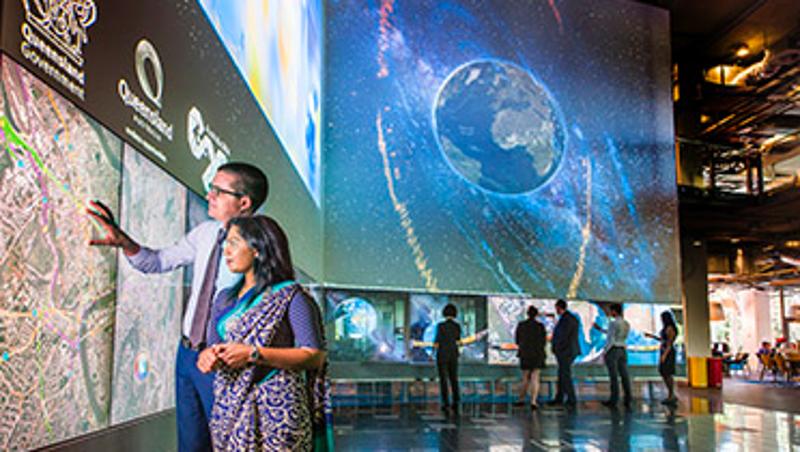
QUT has developed a world-first display that will showcase Queensland to G20 delegates and visitors.
Purpose-built for The Cube, the world's largest digital interactive installation based at QUT's Gardens Point campus, the spatial platform displays a vast amount of the Queensland Government's open data sets and satellite imagery so G20 visitors can easily explore trade and investment opportunities within Queensland.
The massive immersive platform will be seen by G20 delegates, business leaders, expert groups, media, tourists and local residents.
Project leader and QUT Visualisation and eResearcher Manager Gavin Winter said the platform was developed in partnership with the Queensland Government.
"We've designed The Cube Globe as a narrative underpinned by hard data that is geographically referenced to satellite imagery," Mr Winter said.
"It uses state-of-the-art immersive visualisation, interactive maps, animation and multi-media design to tell compelling stories about Queensland's performance in key economic sectors."
The Cube Globe will light up the exterior of Brisbane's Magistrate's Court as part of the nightly Colour Me Brisbane installation, one of the G20 cultural celebrations.
Executive Director of QUT's Institute for Future Environments Professor Ian Mackinnon said, following the G20 Leaders' Summit, The Cube Globe's development team would adapt the platform for educational purposes and for mobile devices and other installations worldwide.
"QUT is actively building world-leading capabilities in spatial research and data visualisation because we know spatial information and its technology platforms are a key to managing the world's finite resources in a sustainable manner," Professor Mackinnon said.
"Our broader goal with The Cube Globe is to help communities realise their place in the world, understand what happens around us, and to meet the challenges and opportunities we face now and into the future."
Almost two years old, the two-storey Cube remains the world's largest digital interactive installation - incorporating 48 touch screens, six large-scale projection screens and 55 speakers, all connected to a high-powered computing cluster.
It was designed, prototyped, developed and built by QUT staff, whose expertise is now being sought globally for a range of business, research and philanthropic collaborations.
All but one of the 10 programs currently on display at The Cube were developed by QUT staff, right down to the skin on the whale in the Virtual Reef installation, which was drawn by hand to achieve its realistic look.
"The Cube involves physical facilities, IT and content design, so creating and maintaining it involves a large collaboration of staff across the university - it's as much an organisational entity as it is a physical entity on campus," Mr Winter said.
"Together, we've been able to solve critical issues that developers of other large-scale public display spaces are learning from.
"For instance, instead of using the touch screen technology that smart phones use, our screens each uses 32 infrared cameras to track finger and hand movements. This allows many people to interact with the touch screens at the same time.
"The fundamental research questions we are answering about large-scale public displays during the course of creating every new program for The Cube are informing organisations around the world."
The Cube is the public face of QUT's new Science and Engineering Centre, and both have been designed to showcase QUT's education and research capabilities in the science, technology, engineering and mathematics (STEM) disciplines.
Many of The Cube's installations link directly to Australia's national STEM high school curriculum.
The Cube has attracted a number of philanthropic corporate partners to help QUT deliver curriculum-based STEM programs to schools and engage the public in a range of fun and educational activities and workshops, including LEGO Education® and Australian-based companies Ausenco, ALS Limited, AMX and SGI.
QUT staff working with the Cube are collaborating with Microsoft Research to adapt its WorldWide Telescope (WWT) for large-scale touch-screen environments. WWT is a web portal that brings together imagery from the world's best telescopes, enabling people to explore the universe from their desktop.
They are also working with National ICT Australia, the nation's largest organisation dedicated to ICT research, to enhance spatial information technologies internationally.
The Cube's tech specs:
- 190 sq. metres of display surface, appox. 145 megapixels.
- Over 30 High-powered SGI graphics computers and HP servers, with a total of 64 CPUs, 64 GPUs, over 1 terabyte of RAM.
- 48 MultiTaction™ touch panels.
- 14 Panasonic high-definition projectors.
- 55 custom-made speakers.
- 4 dedicated gigabit Ethernet networks.
- Direct connection to AARNet and the internet.
- Dedicated enterprise-class data centre.
RELATED STORIES
Cube residencies a headline act for artists
Confused about chemistry? Try this textbook on for size
Innovation Cubed: QUT helps big business build a digital future
Forget Sochi - it's gold, gold, gold to the Cube!
Media contact:
Kate Haggman, QUT Media, 07 3138 0358, kate.haggman@qut.edu.au
After hours, Rose Trapnell, QUT Media team leader, 0407 585 901




